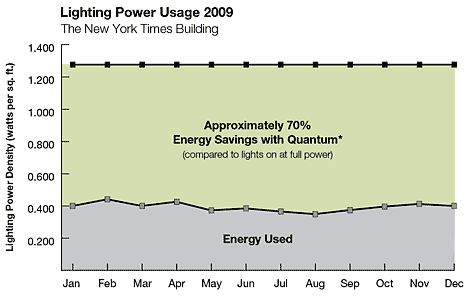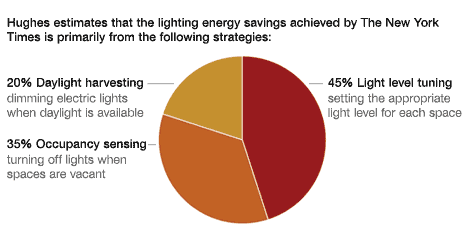|
|
Case study: The New York Times Building Lutron’s Quantum solution makes “front-page” news within The New York Times Company for creating a dynamic and energizing work environment and for delivering nearly 70% energy savings.
|
|
“We designed our building to use 1.28 watts per square foot of lighting power. With Quantum, it’s only using 0.396 — that’s about 70% less.” - Glenn Hughes, Director of Construction for The New York Times Company  All eyes in the architectural and green communities remain on the 52-story headquarters of The New York Times Company as its Quantum total light management system continues to outdo itself in energy efficiency, saving the company significant money. An analysis of the full year’s data for 2009 shows the Quantum system continues to achieve dramatic energy savings, claims Glenn Hughes, presently an international energy consultant. “The energy savings are stunning,” says Hughes. “Lutron’s Quantum total lighting management system has delivered an absolutely over-the-top performance. When I talk with other construction and lighting consultants, they’re astonished at the results.”
|
|
|
Hughes asserts that, based on current NYC code (1.0 watts/sf lighting power density) and a New York City commercial building electricity rate of $0.18 per kWh, the savings opportunity from using Quantum is approximately $1 per square foot per year.
|
In addition to these savings, there is a derivative effect from Quantum on the HVAC system energy performance. The dramatically reduced output levels of the lighting system means that less heat load is created by the lights, which means the air conditioning system works less, further reducing energy use in the building.
 Hughes says, “total light management represents the single greatest opportunity for energy savings in commercial buildings, whether retrofit or new construction projects.” One of the most important features of the system is the robust database that collects system performance details continuously. This enables the user to analyze and optimize system performance. Hughes indicates that the data recently evaluated for 2009 shows consistent performance with earlier results. The system began with tremendous results and continues to deliver the same performance now more than two years since start-up. Average lighting power density for all The New York Times Company space in 2009 was 0.396 watts/sq. ft. Peak lighting power density (the single worst hour of the year for 2009) was 0.76 watts/sq. ft. Putting this into perspective, Glenn says that this peak represents 40% better performance than the original design. He also presents this data to the design community and challenges them to design the lighting systems to levels well below code because we know it can be accomplished, citing the building’s performance as the evidence. In fact, the American Institute of Architects has taken the stand that for the next decade, architecture should be influenced by evidence-based design. Hughes says that the story doesn’t end by looking at energy savings alone. Quantum dramatically improved the lighting environment inside The New York Times Building. According to Hughes, assuming a mere 1% increase in productivity (a conservative estimate), from the improved lighting environment, the Quantum system paid for itself in less than a year. He also emphasizes that this value-add goes on year after year. First published in 1851, The New York Times has long enjoyed pride of place among all news organizations in the United States. The Times is a time-tested institution operating in the American media capital and the most fabled city of the modern world where supremacy is the norm. It’s an organization that understands that what it says and does reverberates across many borders. It’s no surprise, then, that when the newspaper’s parent company, The New York Times Company, a global media enterprise, decided to build a new headquarters in Manhattan, it eschewed the idea of maintaining a passive role in the project. The company resolved to exercise control at every stage of the project’s design and construction processes, ensuring that the new building accurately represented its corporate culture and values, and reaped real business benefits for the company. “We desired an interior environment that allowed our employees to be as comfortable as possible and that would reinforce our company’s emphasis on open communication, collaboration and transparency,” said David Thurm, former Sr. Vice President of the Times Company. To accomplish these objectives, the Times Company hired the world-renowned architect Renzo Piano, along with two major architectural firms, FXFOWLE of New York, and Gensler, headquartered in San Francisco. The Times Company also employed the lighting design services of SBLD Studio of New York.
|
The result is a dazzling 52-story tower with 1.5 million gross square feet. The building is a mix of office and retail. Its chief attributes are open spaces and floor-to-ceiling glass walls that provide building occupants wide views of the neighboring skyscrapers and, conversely, allow outsiders to look in.
|
|
The importance of lighting controls was recognized by the Times Company from the start. Executives extensively researched the state-of-the-art lighting control options to satisfy their twin desires for daylight harvesting and for the flexibility to reconfigure spaces easily and simply. The word “extensively” is not used loosely. As Thurm himself described in an article published in the Harvard Business Review, virtually every decision fell under tight scrutiny to drive innovation and to avoid what he called, “well-intentioned guesses by others as to what you want.” “When you have a client interested in exploring new territories it is very exciting,” said Edward Wood, Principal and Design Director for Gensler—the interior architect for NYT. “The entire project was a big research study.” Another Gensler principal echoes that sentiment: “Because they are a media organization, they are very research-oriented, very probing, always asking a lot of questions and challenging the status quo,” said Rocco Giannetti, AIA. The research eventually gravitated to the Building Technologies Department at the Lawrence Berkeley National Laboratory at the University of California. With guidance from the Berkeley Lab, the project design team, and manufacturers, the Times Company built a replica of the southwest corner of its new building at one of its printing facilities in Queens, New York. For six months, from winter solstice to summer solstice, the mock-up tested an array of different lighting technologies and products from a variety of manufacturers—including a new technology just emerging from Lutron Electronics Co. Inc. The testing, plus Lutron’s response to a competitive bid, convinced the Times Company to select Lutron’s Quantum light management solution for its office space. Quantum employs a number of different strategies—including daylight control, occupant control, target set point control (light level tuning), time clock control, and emergency lighting control —to give building occupants maximum comfort, and to give business owners the flexibility to adapt their work environments to meet changing business requirements. Quantum also features software to control, monitor, and report on the lighting usage in the building. “What we have achieved with our building is spectacular,” said Thurm. “But any office space eventually needs to move in different directions and this lighting system gives us the flexibility to change as we see fit.” With Quantum, the daylight sensors make the most of natural light pouring into a space, continually and imperceptibly adjusting the electric light levels accordingly– all the while maintaining a consistent overall light level as set for the people working in that space. “With all the daylight coming in, the avoidance of glare was a crucial issue to the client,” said Attila Uysal, Principal and Technical Director of the lighting design firm, Susan Brady Lighting Design Studio. “Lutron’s involvement from the beginning was invaluable.They understood that the ‘quality’ of the lighting mattered as much as anything—and they were able to deliver a highly sophisticated digital lighting system with a very powerful control software tool that’s easy to use and that carried the clients’ wishes to the nth degree. Everyone was impressed.”
|
|
|
Uysal said every floor’s lighting scheme is divided into zones, each with its own lighting levels that fit the needs of the employees (depending on what type of work they perform) and based on the amount of daylight that penetrates that space. Over 15,000 digitally addressable EcoSystem ballasts were used to achieve that kind of precision, according to Hughes.
|
|
The Times Company executives report increased employee satisfaction. Lighting is a vital component of any construction project, serving as a favorite ‘form and function’ instrument of architects designing a space. It reveals volume, area, ideas of scale, and it allows a building’s occupants to interact with their environment. As such, it affects workers’ comfort levels and, in turn, their productivity. However, as any building owner or tenant can attest, this function comes at a steep price: the cost of electricity. “As a company,” Thurm said, “we intuitively understood that, if we were going to work in a building with so much outer glass, we had to keep a rein on our energy consumption. That helps our bottom line but also is the environmentally responsible thing to do.” Employee comfort, increased productivity, reduced energy usage, and ease and flexibility of use—is there a big story here? The New York Times Company already has decided.
|
|
|
|
|
|
|
|
|
|
|
|
|
|
|
|
|
|
|
|
|
|
Quantum A total light management system that allows central monitoring of an entire building, allowing for considerable energy savings and optimal performance.
Learn more Products used in this project Quantum EcoSystem Download the PDF English
|
